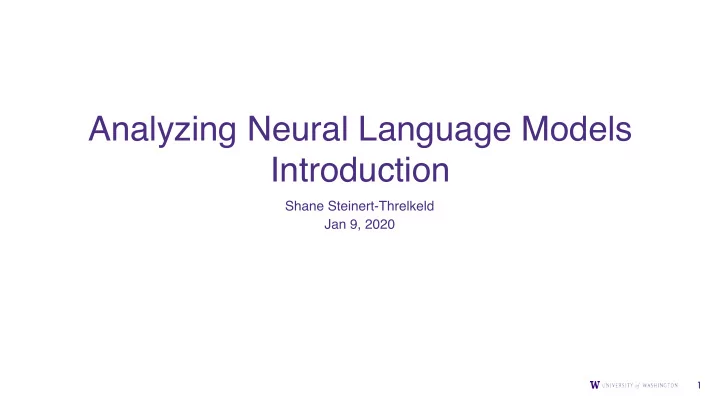

Sidebar: Word Embeddings ● Aren’t word embeddings like word2vec and GloVe examples of transfer learning? ● Yes: get linguistic representations from raw text to use in downstream tasks ● No: not to be used as general-purpose representations 38
Sidebar: Word Embeddings 39
Sidebar: Word Embeddings ● One distinction: ● Global representations: ● word2vec, GloVe: one vector for each word type (e.g. ‘play’) ● Contextual representations (from LMs): ● Representation of word in context, not independently 39
Sidebar: Word Embeddings ● One distinction: ● Global representations: ● word2vec, GloVe: one vector for each word type (e.g. ‘play’) ● Contextual representations (from LMs): ● Representation of word in context, not independently ● Another: ● Shallow (global) vs. Deep (contextual) pre-training 39
Global Embeddings: Models 40
Global Embeddings: Models Mikolov et al 2013a (the OG word2vec paper) 40
Shallow vs Deep Pre-training Model for task Model for task Contextual embedding (pre-trained) Global embedding Raw tokens Raw tokens 41
NLP’s “Clever Hans Moment” Clever Hans BERT link 42
Clever Hans ● Early 1900s, a horse trained by his owner to do: ● Addition ● Division ● Multiplication ● Tell time ● Read German ● … ● Wow! Hans is really smart! 43
Clever Hans Effect 44
Clever Hans Effect ● Upon closer examination / experimentation… 44
Clever Hans Effect ● Upon closer examination / experimentation… ● Hans’ success: 44
Clever Hans Effect ● Upon closer examination / experimentation… ● Hans’ success: ● 89% when questioner knows answer 44
Clever Hans Effect ● Upon closer examination / experimentation… ● Hans’ success: ● 89% when questioner knows answer ● 6% when questioner doesn’t know answer 44
Clever Hans Effect ● Upon closer examination / experimentation… ● Hans’ success: ● 89% when questioner knows answer ● 6% when questioner doesn’t know answer ● Further experiments: as Hans’ taps got closer to correct answer, facial tension in questioner increased 44
Clever Hans Effect ● Upon closer examination / experimentation… ● Hans’ success: ● 89% when questioner knows answer ● 6% when questioner doesn’t know answer ● Further experiments: as Hans’ taps got closer to correct answer, facial tension in questioner increased ● Hans didn’t solve the task but exploited a spuriously correlated cue 44
Central question ● Do BERT et al’s major successes at solving NLP tasks show that we have achieved robust natural language understanding in machines? ● Or: are we seeing a “Clever BERT” phenomenon? 45
McCoy et al 2019 46
47
Results (performance improves if fine-tuned on this challenge set) 48
link 49
Recent Analysis Explosion ● E.g. BlackboxNLP workshop [2018, 2019] ● New “Interpretability and Analysis” track at ACL 50
Why care? ● Effects of learning what neural language models understand: ● Engineering: can help build better language technologies via improved models, data, training protocols, … ● Trust, critical applications ● Theoretical: can help us understand biases in different architectures (e.g. LSTMs vs Transformers), similarities to human learning biases ● Ethical: e.g. do some models reflect problematic social biases more than others? 51
Stretch Break! 52
Course Overview / Logistics 53
Large Scale ● Motivating question: what do neural language models understand about natural language? ● Focus on meaning , where much of the literature has focused on syntax ● A research seminar : in groups, you will carry out and execute a novel analysis project. ● Think of it as a proto-conference-paper, or the seed of a conference paper. 54
Recommend
More recommend